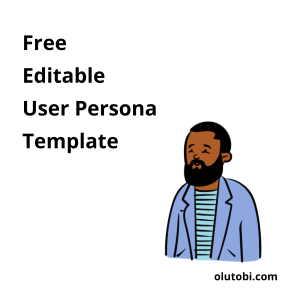Creating a user persona for any product or service is essential. It helps in defining your target audience and understanding their preferences, behaviours, and pain points. I’ll walk you through the process of creating a user persona for your product. You’ll learn how to collect data on your target audience, create a user persona and use that persona to guide your product development process.
What is A User Persona?
A user persona is a fictional representation of your target audience. This includes their demographics, behaviours, motivations, and pain points. Creating a user persona helps you prioritize what you build or how you develop your product.
 How to Create a User Persona
How to Create a User Persona
- Identify your ideal customer
- Conduct market research
- Write a summary
- Tell us about the customer’s goals
- Write about their pain-points (or problems)
Identify Your Ideal Customer
Start by identifying your ideal customer. This person should be someone who is most likely to use your product or service and is in desperate need of it. Consider their age, gender, location, interests, and habits. Consider their problems, obstacles, and what motivates them to seek out your solution. This will assist you in developing a clear picture of your target audience and what they require from your product or service.
It’s critical to remember that you can’t make a product or service that appeals to everyone. As a result, it’s best to concentrate on developing one or two personas that represent your ideal customer. This will assist you in developing a solution that will resonate with a specific group of people and will be more likely to produce results.
Once you’ve identified your ideal customer, consider why your product or service is essential for them. What problems does it address? What difference does it make in their lives? Answering these questions will help you gain a better understanding of your customer’s needs and preferences, allowing you to tailor your messaging and branding accordingly.
Conduct Customer Research
If you want to create a representative user persona, you must first research to better understand your target audience. If you’ve already generated some leads or sales, you can leverage that historical data and customer insights to gain a thorough understanding of your ideal customer.
One method is to speak with potential customers and ask them open-ended questions about why they use specific products. You can identify patterns in their responses and gain valuable insights into their preferences and needs. Speaking to about 5 people is fine.
Another method of research is to examine how users interact with competitors’ products or other products that serve the same general purpose as yours. For example, if you’re developing a product or service to help people unwind, you could look at how potential customers spend their time doing things like going to the mall, the movies, or the beach. This can assist you in identifying common features in how people use these products which will help you tailor your solution.
Write a Summary
Provide a big picture of the person’s life.
- Ethnic background,
- Work/occupation
- Age
- Family life: marital status, children, pets
- Add hobbies: Walks their dog. Goes to the gym. Stops at the coffee shop every morning.
Customer’s Goals
Tell Us About the Customer’s Goals
Pain-points
Capture whatever pain points they might have
- Financial: So many wants and needs, not enough money
- Productivity: So much to do, so little time.
- Process: We all want better ways of living. We all want something to be fixed or better.
- Support: Not having help to achieve their goals.
Once you’ve created your user persona, make frequent use of it as you build or scale your business. As you gain more insights and data, continue to update and refine it to ensure that your product remains relevant and resonates with your target audience.
With a well-defined user persona, you can create a solution that meets the needs of your ideal customer while also driving business success.


